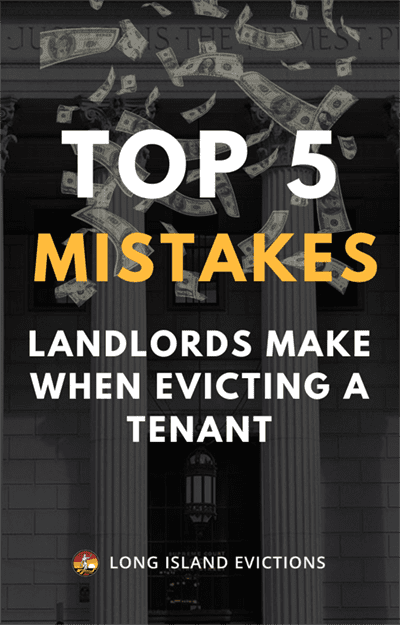What is the process to evict a residential tenant from an apartment on Long Island?
Most landlords will eventually be confronted with the eviction process and the need to hire a landlord tenant lawyer when they have to evict a tenant, either for non-payment of rent, for other violations of the rental agreement, or because the tenant is holding over past the expiration of his or her tenancy.
Whether you have tenants who stopped paying rent, or you just want your tenants to move out, this article should explain more about the process.
Text Us
Have a Question? Text Us For Free.
We offer free consultations via phone, text or chat. Don't wonder about what your rights are or what your next move is. Call and find out.
(516) 274-7912Text Us NowThe first step is to determine the type of eviction proceeding to bring.
The two most typical types of actions initiated to evict a tenant in Nassau and Suffolk County are:
Non-Payment Proceedings – A non-payment proceeding is initiated to evict a tenant because the tenant has failed to pay rent, despite the landlord’s demand for payment. A non-payment proceeding is generally faster than a hold-over proceeding, but if the tenant pays the back rent owed on or before the court date, the Court will dismiss your case and will allow the tenant to remain in possession of the premises. If you are willing to allow your tenant to remain if they pay the back rent owed, a non-payment proceeding may be the solution for you.
Once you determine the type of eviction proceeding to bring, then there's typically 5 steps to take to evict your tenant.
Step 1: We Draft and Serve a Notice to Terminate Tenancy
Once you know the type of proceeding you wish to initiate, we will determine what type of notice, if any, must be served on your tenant before commencing the proceeding. The type and content of the notice and the method of service depend on many factors, including the type of tenancy, the reason for the eviction, and the requirements of the written rental agreement, if any. Because the legal requirements of such notices are extensive, you should consult with a Nassau County or Suffolk County tenant eviction lawyer before trying to serve a notice on your own, or preferably let your landlord tenant attorney handle it for you. Often landlords serve their own form of notice that they’ve downloaded from the internet or found in a book, which commonly has no legal effect, and only serves to delay the eviction of your tenant. When you retain us as your landlord tenant attorney, we will draft the proper notice to terminate the tenancy for you at no additional charge.
Step 2: We Commence an Action to Evict Your Tenant
The correct forum and venue for the action must be determined, based on the location of the property. A notice of petition with petition will then be drafted and finalized by your landlord-tenant attorney, and filed in the appropriate court. A filing fee must be paid to the clerk of the court, who will usually assign an index number at the time of filing. When you retain us as your New York tenant eviction lawyer, all court filing fees are included in our fee.
The notice of petition with petition must then be properly served on your tenants in accordance with the Real Property Actions and Proceedings Law, and affidavits of service must be executed and timely filed with the court before your appearance date.
Step 3: We will appear in court on your behalf on the date the petition is noticed to be heard
If your tenant requests an adjournment, or if the Court adjourns your matter, we will fight to have your case heard as soon as possible, and we will appear at every court date at no additional charge to you. We will conference your case with your tenant and the judge, and if necessary, we will conduct a trial before the judge to receive a court order allowing for the physical removal of your tenant from the premises, as well as a money judgment, if applicable.
If a trial is necessary, the landlord, or someone with personal knowledge of the facts of the case may be required to appear in court and testify. As your evictions lawyer, we will guide you and prepare you in advance for your appearance, and we will advise you with particularity as to each step in the tenant eviction process.
Step 4: After your case is won, we will submit a proposed judgment and warrant of eviction to the court
Once your trial is over, the judge will issue his or her decision. If you prevail, your Long Island lawyer will draft a proposed judgment (both for money, if awarded, and for possession) and a warrant of eviction on your behalf and will submit them to the court with payment of the fee for a transcript of judgment. Drafting a proposed judgment and warrant of eviction, submitting them to the court, and paying the court’s fee for your transcript of judgment is included in our service.
You will need a transcript of judgment if you plan to enforce your judgment and have your warrant of eviction executed. Once submitted, we must then wait for the judge to approve and sign your judgment and warrant, and mail them to us. We will forward them to you with further instructions, typically the same day we receive it. This is the conclusion of the courtroom part of the eviction process.
Step 5: Physical removal of your Nassau County or Suffolk County tenant
Usually tenants who lose at trial vacate the premises shortly thereafter. They feel defeated, and know it’s time for them to move on. In some cases, tenants will still refuse to leave the premises, or simply have no other place to go, and you will have to contact the Nassau County or Suffolk County Sheriff’s Office to physically remove them. If you retain us, we’ll give you explicit instructions and guide you through your contact with the Sheriff’s office.
The first action the Sheriff will take will be to serve your tenants with a 14-day notice, advising them that they have 14 days to vacate the premises or they will be physically removed. If your tenants still have not vacated the premises at the expiration of the 14-day notice, the Sheriff will return sometime thereafter and physically remove your tenants and their belongings and return possession of the apartment back to you. If the tenant causes damage to the property in excess of any security deposit you may be holding, you can start a new court action to recover your losses.
As you can see, the eviction process on Long Island is complex, and there are strict requirements that must be followed before a court will grant you a money judgment for the back rent owed, and a warrant of eviction to physically remove your tenant.
As always, if you need an experienced Long Island eviction lawyer on your side, we can help you right now. Just give us a call for a free consultation.












